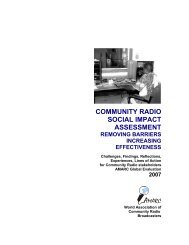WHAT IS COMMUNITY RADIO - amarc
WHAT IS COMMUNITY RADIO - amarc
WHAT IS COMMUNITY RADIO - amarc
You also want an ePaper? Increase the reach of your titles
YUMPU automatically turns print PDFs into web optimized ePapers that Google loves.
Some donors will provide guidelines to help community radio stations drawing up their funding<br />
proposal. However, other donors will leave it to the station team to draw up the proposal themselves.<br />
In such cases, the following format could be useful.<br />
What is also important when submitting your proposal is a letterhead saying who and where you are.<br />
This presentation letter needs to state clearly the service or activity that is provided, with relevant<br />
information on the target group, and the assistance requested from the donor.<br />
The proposal itself could be presented as follows:<br />
A. Summary<br />
This first page sums up the entire document. On this page one should list:<br />
1. The name of the community radio station;<br />
2. The names of the persons to contact for additional information;<br />
3. The address and telephone and fax numbers to reach these contact persons;<br />
4. The legal status of the station (association, trust or foundation’s registration information);<br />
5. The broadcasting license details (still in process, or issued by which authority, on what date);<br />
6. The frequency allocated (if any, otherwise are you applying for AM or FM frequency);<br />
7. The audience it reaches (number of listeners, area covered, and broadcasting radius);<br />
8. The programming content (in a few words, the kind of programmes);<br />
9. The object of the proposal (the funds are required for operational or establishment activities);<br />
10. The amount requested from the donor;<br />
11. The amount and goods & services already secured by the station.<br />
B. Funding proposal<br />
These pages will describe your community radio station and its need for assistance.<br />
1. Background<br />
(History of the radio project in the targeted community and national context, including when the<br />
project was formed, what research was done, what community support it has and the existing<br />
achievements of the project. It is also crucial to mention who is already supporting the station and<br />
it might also be helpful to attach in annexe some letters of support from well-known community<br />
organisations supporting the project.)<br />
2. Beneficiaries<br />
(Description of the targeted community and participants in the station. It will be important to give<br />
facts and figures where necessary, with an analysis of their situation, showing how the project can<br />
uplift the plight of the people it will serve.)<br />
3. Mission statement<br />
(Include the community radio station’s mission and a section listing the specific objectives of the<br />
station, as developed previously.)<br />
4. Organisational structure and community involvement<br />
(Diagram of the structure - AGM, Board, Management Committee, etc. - and names of elected<br />
leaders and key staff members. Other relevant information includes the calibre of the human<br />
resources available within the project and a description of how is the community involved in<br />
planning and managing the project.)<br />
5. Management policies<br />
(Description of all the station’s policies or internal rules, codes of conduct, job descriptions, lines<br />
of accountability, etc.)<br />
6. Programming policies and content<br />
28<br />
What is Community Radio? A Resource Guide<br />
Published by AMARC Africa and Panos Southern Africa in collaboration with IB<strong>IS</strong>/Interfund and WACC

















